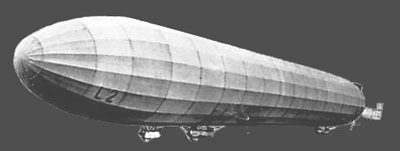The Naval Airship L2

The navy airship “L2” was the largest of all the Zeppelin airships ever built.
A similar catastrophe, as it has affected the “L 1”, appeared to the “L 2”, which had twice the reserve ballast, quite impossible.
The prevailing air-currents at sea, which are more constant than in the country, but therefor act with even greater force, had also made a reinforcement of engine power necessary. The machinery of 720 horsepower are capable to defy even strong storms.
But also outwardly the “L2” did not differ insignificantly from the first naval airship. The heavy service, that officers and crew had on seafarings in the same way, had made a greater protection of the crew and, even though small, comfort necessary. Thus the accomodations situated on the gangway were created more practical than before. The system of wireless telegraphy had been substantially increased. Two radio operators shared the operation of the instruments.
One innovation was the installation of the two powerful spotlights, which were not fed as before by an accumulator battery, but by a dynamo, whose drive was caused by one of the motors in the front gondola. In the middle of the ship there was a platform attached to the air crusier’s back, which offered place to four or five people. There could also a revolving gun been set up, which was designed so that the area under the ship could be swept up to an angle of up to 45 degrees.
The airship had a length of 160 meters, a diameter of 16 1 / 2 feet, had a control gondola, and two engine gondolas, each with two engines.
The gas content of the 18 cells was calculated to 27,000 cubic meters. The four engines, of which the two in front developed each 150, the ones rear each 200 horsepower, were – according to the Maybach’s principle- built in Friedrichshafen.
The crew consisted of 3 officers, 4 mates, and 12 mechanics. Due to its high load capacity, the crew could be doubled in case of emergency. According to the calculations of the engineers of the Zeppelin airship company should this be the first airship that would have been able to run without any greater risk the voyage across the ocean to America.


